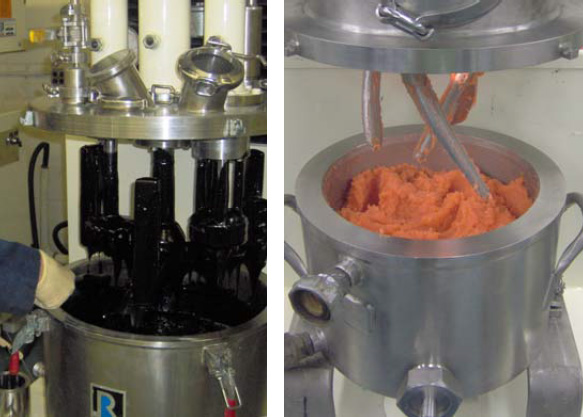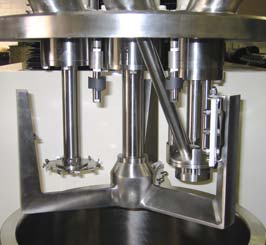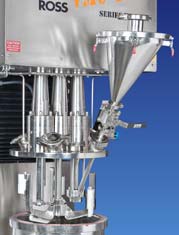Tech Report
Mixing viscous suspensions

Technology Brief
Solid-liquid suspensions are prepared in different types of mixing equipment, depending on viscosity and shear level requirements. This bulletin presents some mixer solutions for efficient and consistent dispersion of solid raw materials into a viscous liquid.
Selecting the best mixer for your suspension
Many modern products are processed as suspensions consisting of solid particles dispersed in liquid. Depending on the chemistry of the raw materials, suspensions take on a wide range of rheologies - from a low-viscosity slurry or a flowable gel to a thick heavy paste. Whether it`s a paint formulation, sunscreen lotion, ceramic composite, battery paste or pharmaceutical drug, mixer selection is primarily dictated by two parameters: viscosity and shear energy. The main mixing objective is to completely wet-out the individual solid particles and create a stable suspension.Any presence of undispersed agglomerates in the mixture can lead to defects in the final product, poor performance, low strength, shorter shelf-life and other undesirable properties. While a number of mixer designs may be suitable for your particular process, selecting the best configuration is important in optimizing cost, efficiency, and lot-to-lot consistency.
A new take on solids dispersion

The biggest challenge in solid-liquid mixing is obtaining a thorough dispersion. To this end, high speed devices such as saw-tooth dispersers and rotor/stator mixers are commonly employed, often in combination with a low speed agitator designed to promote bulk flow and uniform temperature throughout a viscous batch. This multi shaft mixer configuration is suitable for formulations that are several hundred thousand centipoise.
Conventionally, solids are charged right on top of the batch when the mixer is stopped or added through the cover while the liquid is being agitated. This step of the mixing process is sometimes a bottleneck especially when dealing with powders that tend to dust, float on the liquid surface or form agglomerates. One solution is to utilize a rotor/stator mixer designed for sub-surface powder induction. For instance,Ross Multi-Shaft Mixers are commonly supplied with the Solids/LiquidInjection Manifold (SLIM) System either built into the batch rotor/stator or as an external inline (recirculation) unit. Powders like silica, carbon black, graphite, talc, alumina, bentonite clay, titanium dioxide and other pigments are quickly introduced into the batch by virtue of the vacuum-generating SLIM rotor. By drawing solids right into the high shear zone, theSLIM helps eliminate dusting, floating powders and lumps. For optimal performance, liquid viscosity must remain below 20,000 cP during powder induction.
High viscosity planetary mixing

As viscosity continues to climb into the 1 million cP range, a multi-shaft mixer arrangement will eventually fail to produce adequate material turnover. The logical solution is to utilize agitators that move through the batch regardless of product flow characteristics. This is the forte of planetary mixers.
Double planetary mixers are well proven equipment for the processing of highly viscous suspensions. They move batch material by rotating two identical blades on their own axes as they orbit on a common axis. Most traditional double planetary mixers utilize rectangular paddle blades which are capable of handling viscous products up to 3 million cP. Newer helical planetary stirrers like the Ross HighViscosity "HV" Blades extend the mixer`s viscosity range to 6 million cP or more.The double planetary mixer operates at relatively low speeds and thus relies on high product viscosity to impart shear and disintegrate any agglomerates in the batch.
When working with viscous materials in the range of 100,000 cP to around 2 million cP, a planetary disperser may be more efficient in creating a fine suspension. The classic design consists of a planetary stirrer and a high speed disperser that revolve on their own axes while orbiting the vessel. Shear levels and flow patterns are easily fine-tuned because the agitators are individually-controlled.
More demanding applications benefit from two planetary stirrers and two disperser shafts. The combined mixing action of these agitators is ideal for rapid incorporation of large amounts of solids into a viscous vehicle with no risk of localized heat build-up. Formulations that undergo a viscosity peak mid-processing, even if the final viscosity is manageable in a multi-shaft mixer, are also ideal candidates for processing in a planetary disperser.
Ross Mixers used in preparing high quality suspensions:
Low to Medium Viscosity

High Speed Dispersers and Rotor/Stator Mixers
Medium to High Viscosity

Multi-Shaft Mixers
High Viscosity

Planetary Mixers